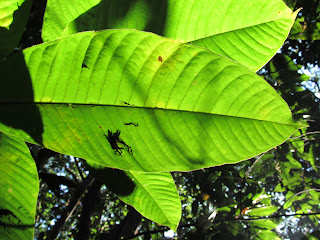Just ask a taxi driver to go towards the CAVITEX, but DO NOT GO THROUGH THE TOLL, or you have passed it, come off immediately right just before and head up the gravel track to the security gate, but make sure you do not turn back on yourself, with the carriageway you just came in on, on your right.
Leaving is trickier, because all the traffic is coming from your left towards the CAVITEX toll gate there is no way of flagging down a taxi back to MOA, The only way, other then getting real lucky with a taxi coming from the weighbridge or nearby offices, is leave on foot up the track parallel to the carriageway, you then have two choices, take the first footbridge over the dual carriageway, it's huge you can't miss it, or you can walk all the whole approximately 1km track to the entrance to the fish market, I did this and got a bicycle ride back to Paranaque town as I was already tired from the 1km walk.
I advise taking the bridge, it's a lot nearer and where you cross puts you on the West side of Paranaque itself so all you have to do is walk more or less East until you hit a bigger road. If you are there on a low tide, there will be plenty to look at on the mud on your left. Once you go over the bridge be prepared for wandering through all of Paranaque's street market, an eye opener to the uninitiated, but fun and interesting for me, to see a different culture in it's everyday life.
Anyway, it's not easy to navigate the allies and side roads, but keep going East'ish with the market streets on your left and you'll find a big enough road to flag a taxi back to MOA. Trust me you'll get lots of smiles and "hey Joe's" if you're white and I never feel threatened walking along with all my birding kit draped over me.
So back to arrival to bird, drive up to the gate and if you arrive at 04:55, you'll be met by some sleepy looking guards who may, or may not ask you for you permit to bird watch. I was allowed in, but told I would need it for future visits. My new friend there says it is rather random whether you get asked. If in doubt, do inquire with the wild bird club of the Philippines and I'm sure they can advise.
Looking East just after the gate:
Pond 2
A couple of record shots of two species on pool 2, Jerdon's Little-ringed Plover and White-browed Crake.
It took me 45 minutes to see 1 Black-naped Monarch, not a lifer, but hearing it's rather beautiful song for the first time, I hope it is now embedded in my memory. A short clip on Xeno doesn't capture all of it, as it much more trilling in full song, rather canary like. http://www.xeno-canto.org/species/Hypothymis-azurea?query=ssp:%22azurea%22
I made my way a little further into the island this time, finding a short section of bamboo boardwalk, it doesn't go anywhere and was worse for wear, so I jumped off and stood in the mangroves for 20 minutes just listening and contemplating the rubbish.
This was my fourth of fifth trip here and I am certain there were a lot less birds than 2014. Less Night Heron, 1 Rufous, 1-2 Striated Heron, less than 15-20 Clamorous Reed Warbler, 1 Philippine Duck in flight, no Stilts, no Trillers, 1 Barred Rail, no Grassbirds, 1 Collared Kingfisher, 3-4 Philippine Tailorbird, , 2 Sunbird, 5+ Golden Bellied Flyeater.
As it was high tide the just a few egrets were on the sea facing side, distant waders among the rubbish were either Greenshank, or Tattler.
A group of Barn and Pacific Swallow were perched on the wires by the entrance to the island as I left
Sitting at my desk back home in the UK, I wonder the fate of Freedom Island? Will it become a much needed high quality international airport? Will it become more degraded as the population continues to explode and vanish under the endless flow of plastic bags and other rubbish washed down the river, or pushed back in by the tide?
Or will it remain protected and be developed as a nature reserve, improving the viewing screens, maybe even a tower?
Only time will tell?




























































































